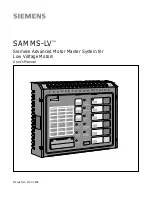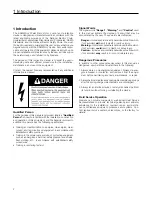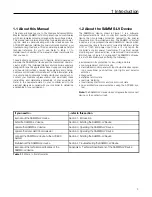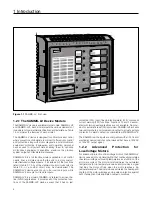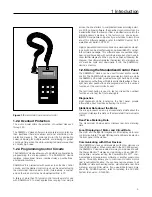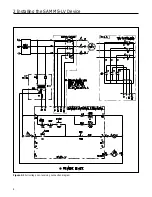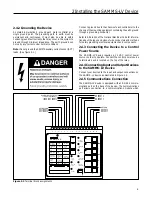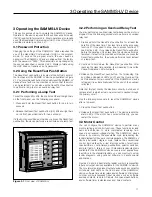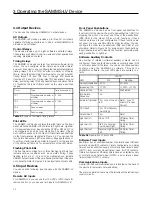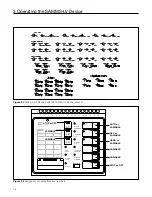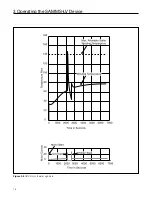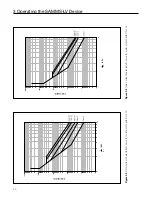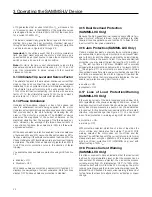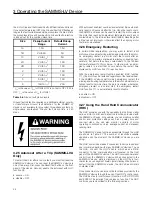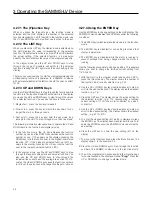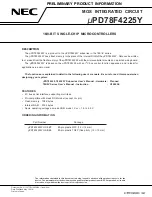
11
3 Operating the SAMMS-LV Device
3 Operating the SAMMS-LV Device
This section explains how to operate the SAMMS-LV device.
Operation of the device requires that the unit have control power
(12VAC) applied to terminals 5-6. Most operations also require
use of the Hand-Held Communicator (HHC). Use of the HHC is
described in detail in section 3.27.
3.1 Password Protection
Changing the settings of the SAMMS-LV device requires the
use of the Hand-Held Communicator (HHC) in the program
mode. To access the program mode, the user needs a
password. The SAMMS-LV device is shipped from the factory
with the password 0000. This password can be changed by
the user as described in section 3.28.1. Display of data using
the HHC does not require use of a password.
3.2 Using the Reset/Test Push Button
The Reset/Test pushbutton is located at the bottom center of
the front panel of the SAMMS-LV device as illustrated in Figure
3.1. You press this pushbutton to manually reset the SAMMS-LV
device after a fault or a trip condition occurs so that the motor
can be restarted. You can also use the Reset/Test pushbutton
to perform a lamp test or an overload relay test.
3.2.1 Performing a Lamp Test
To test the diagnostic LEDs, the control LEDs and the light bars
on the front panel, use the following procedure:
1. Press and hold the Reset/Test pushbutton for one to two
seconds.
2. Release the Reset/Test pushbutton. (All LEDs and light bars
on the front panel illuminate for two seconds.)
If a fault or trip condition exists when you press the Reset/Test
pushbutton, the device performs a reset instead of a lamp test.
3.2.2 Performing an Overload Relay Test
You may perform an overload relay test whenever the motor is
stopped. Use the following procedure to perform an overload
relay test.
1. Press and hold the Reset/Test pushbutton for at least the
duration of the class time. The class time is set by accessing
function F7. If you need to know how to access function F7,
see Section 3.28. If you release the Reset/Test pushbutton
before the duration of the class time, the device performs a
lamp test. If a fault or trip condition exists when you press the
Reset/Test pushbutton, the device performs a reset instead
of a lamp test.
2. Continue to hold down the Reset/Test pushbutton. After
reaching the class time duration, the Impending Trip and the
Phase Unbalance LEDs illuminate.
3. Release the Reset/Test pushbutton. The Impending Trip
and Phase Unbalance LEDs go off, and the Overload Trip
LED illuminates for two seconds. If the SAMMS-LV device
is tripped, it is automatically reset at the end of the overload
relay test.
Note that this test checks the electronic circuitry, but does not
replace a test in which actual power current is passed through
the primary circuit.
Use the following procedure to reset the SAMMS-LV device
after a trip event.
1. Press the Reset/Test pushbutton.
2. Release the Reset/Test pushbutton. The device resets the
alarm LEDs. If the motor has cooled sufficiently, you can
restart the motor.
3.3 Motor Control
You can configure the SAMMS-LV device to perform many
motor starting and control functions. These functions include
basic across-the-line, to more complicated reversing, two-
speed, and reduced-voltage starting. The SAMMS-LV device
stores in its memory the executable code representing the
ladder diagram for the users control application. The SAMMS-LV
device and ladder diagram code replace the conventional
control logic defined by wired interconnection of electrome-
chanical timers, control relays, pushbuttons, selector switches,
and pilot lights. A library of over 70 standard ladder diagrams
available for the SAMMS-LV device covers most applications.
In addition to the standard ladders, you can construct custom
ladder diagrams, using optional software, to handle special
applications.
Figures 3.2 and 3.3 illustrate the ladder symbols representing
input and output devices available for the SAMMS-LV device.
The circular symbols represent output devices such as contactor
coil drivers, pilot LEDs on the front panel of the SAMMS-LV
device, software time-delay relays and software control relays.
All other symbols represent input devices such as software
auxiliary contacts, remote AC inputs, front-panel pushbuttons,
and software timer instantaneous and timed contacts.
1 2 3
4 5 6 7 8 9 10 11 12 13
14 15 16
Figure 3.1
Front view of SAMMS-LV

